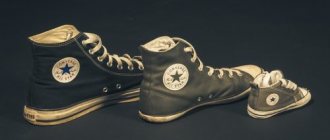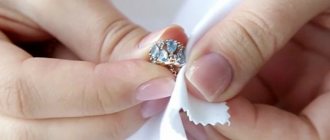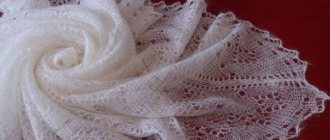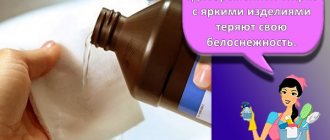A snow-white Orenburg down scarf gives the image incredible femininity and attractive touchingness. But over time, its whiteness fades, and the owner of the scarf sadly thinks about replacing it. Do not hurry! It’s better to learn how to bleach a down scarf, especially since it’s not difficult to do. A little patience, a little knowledge and some special tools - those are all the ingredients.
Will washing help?
One of our articles describes how to wash a down scarf. If the item is a little faded, perhaps a light wash can bring it back to its original whiteness. In any case, the washing rules also apply to bleaching:
- Before immersing in water, it is advisable to carefully comb the product and then collect it on a nylon thread or fishing line. The length of the thread is equal to the perimeter of the scarf.
- The water temperature should not exceed 50, maximum 55 degrees (ideally 40-45).
- Woolen items should not be twisted. To wring out a delicate Orenburg down scarf, you can pass it between your fingers.
- For drying, it is better to use a special frame on which the product is stretched. You can buy it or make it from wooden planks and pushpins. Remember that the size of the frame must match the size of the item.
- If you do not have a special frame, dry the product on the table, spreading it out on a clean sheet or tablecloth. Shake and straighten it periodically.
If washing does not help, use one of the special products. Fortunately, there are many products in household chemical stores that will help whiten a down scarf. Read the instructions carefully and do not exceed the recommended dose. And if such a remedy seems too expensive to you, use one of the traditional methods.
Can I use bleach?
At home, use special products that do not contain chlorine. The best option is a product for bleaching down and down products based on hydrogen peroxide, like “Chistin Omega”. Add two bottles of bleach to a ten-liter container of water. You must follow the instructions on the bottle label. Usually a down scarf is soaked in the evening so that in the morning you can rinse off any yellowish stains, dust and dirt. The easiest way to rinse is in the bathroom, protecting the drain with a mesh.
Important! It is not recommended to frequently use bleaches and household chemicals. The fluff becomes dull, loses strength and easily unravels from the threads.
It’s very easy to return a “second youth” to a down scarf; all you need to know is how to bleach cobwebs at home. It is necessary to choose the appropriate method and follow the instructions exactly, dry the product correctly, then the cape will be pleasing to the eye and will remain white and elegant for a long time.
5/5 — (1 vote)
Method two. Hydroperite and ammonia
To whiten a 100-gram down scarf, you need to dissolve 5 hydroperite tablets in warm water, and then add ammonia to the solution at the rate of a teaspoon per 1 liter of water. Do not take a bowl that is too large, as the down product may stretch during the bleaching process.
Now place the product in water for 10-11 hours. The water should be warm, so from time to time you will have to place the basin on the stove to heat the solution. Make sure it doesn't overheat! 60 degrees will ruin your favorite accessory. Rinse the item thoroughly by adding vinegar to the water.
What to remember
- Wash in warm water with shampoo. In warm water, the wool does not shrink, and the shampoo removes dirt well and fluffs the shawl.
- Comb the fluff before washing. To ensure that the scarf remains fluffy after washing, the fluff should be combed before being immersed in water.
- Hoop dry. The web should be dried on a hoop in a ventilated place.
- Hydroperite, hydrosulfate, and ammonia work well to bleach yellowness. Using hydroperite, hydrosulfate and ammonia to bleach woolen items allows you to carefully deal with the problem.
- Hydrogen peroxide helps stretch shrunken woolen items. Hydrogen peroxide not only effectively whitens, but also makes the thread elastic.
- Aspirin treats yellow spots . To remove yellow spots from fluff, simply treat them with a solution of water and aspirin.
- It cleans dirt from fluff and snow well. Snow baths are beneficial for products made from natural wool and down. They clean well and preserve the structure of the thread.
Safety regulations
Remember that goat fluff by its nature simply cannot be snow-white. It is usually slightly milky with a slight yellow tint. Some fashionistas wear natural colors, others prefer to bleach the item. However, any product can damage the quality of the down. Therefore, before using a method unfamiliar to you, it is better to test its effect on a small piece of fluff. It is ideal if you have some thread left after knitting the product.
Proceed carefully, follow all the rules for washing and drying a down scarf, and then it will keep you warm for a long time, emphasizing your beauty.
Storing a down scarf
Now let's dwell on the issue of storing down products. This is best done by rolling a scarf or other product into a loose roll and placing it in a natural woven bag. It should be kept in a well-ventilated place in the absence of foreign odors. Do not crumple the down product or press it down on top with other things. In summer, in sunny weather, it is recommended to take the scarf outside and shake it slightly - this will refresh and ventilate it.
It is also necessary to protect down products from moths - store-bought products or natural herbs that repel pests will help you with this: mint, wormwood, wild rosemary, lavender and citrus peels (they should be stored in open bags that need to be shaken from time to time).
How to fluff after drying?
To restore the pomp and volume of a woolen scarf, it needs to be fluffed. This is done after rinsing and lightly spinning.
After freezing, the scarf is allowed to completely thaw and then dried using a frame. Next, the fluff is carefully lifted with a comb or a massage comb with blunt teeth. This is done only after the fabric has completely dried; a wet shawl cannot be combed.
Another way to fluff is to hang a dry shawl in the wind. It is also necessary to take into account the fact that when worn, the scarf will naturally become fuller. This is why knitters recommend wearing a knitted puffball as often as possible.
Preparation for the process
Before you begin wet cleaning, the product must be prepared. First, the scarf is shaken to remove all the particles that have not yet become embedded in the down layer.
Then the item is combed with a wooden comb with sparse blunt teeth. This procedure allows you to preserve the fluffy cover of the shawl. Next, using a dry sponge, remove dust and fine dry dirt from the canvas.
If there are stains on the web, they are bleached before general washing. The method of removal depends on the type of pollutant.
To remove colored marks, use an aqueous solution of high concentration aspirin. Of the ready-made chemical preparations, oxygen stain remover intended for children's things is suitable.
How not to spoil something
You can bleach and refresh a downy, yellowed scarf at home without bad consequences if you strictly follow the tips that have proven their effectiveness more than once. Experiments with whiteness, stain removers, and alkali will lead to the destruction of thin threads and deformation of the product.
It promotes the formation of pellets; the once soft and fluffy scarf will become a hard rag. You will have to get rid of such a thing. You cannot use laundry soap, even if you grate it: it will cause a color change.
Proper drying will help you bleach cobwebs safely at home without causing damage. No sun or heating devices. Their action causes the color to fade and yellowness to appear. Hanging it by the corners or drying it on a line is also not an option - the scarf will stretch out and become asymmetrical.
Strict adherence to the recipe, the correct sequence of actions, preparation of the product and choice of the right product will not spoil the web. It will be possible to bleach your home without damaging the appearance of the downy white cobwebs, which, if handled with care, will serve as decoration for many more years.
Source of the article: https://uborkapro.info/stirka-i-himchistka/ruchnaya-stirka/otbelit-puhovyj-platok-doma.html
How to wash a goat down shawl at home: how to properly bleach the white one, how to dry it after washing, how to fluff the product, how to wash a downy shawl from yellowness.
Review of store products
Industrial chemicals specially designed for this purpose will help you bleach white cobwebs at home. Chemicals in liquid form are easily dissolved in water and contain special softening substances that make the fluff light. In addition to softening, they will rid the scarf of dust, dirt, and stubborn stains.
Use grated and dissolved baby soap. The following products have proven themselves to be the best:
- Laska is a domestically produced washing gel for delicate fabrics. The composition of the product can bleach and clean the fibers of a yellowed down scarf if the instructions are followed. The formula is gentle on silk, angora and wool. The White Shine line will help restore color.
- Eared nannies - conditioner for children's clothing will whiten and clean openwork cobwebs without aggressively affecting the down fibers. It will add softness and a delicate aroma to the product. Eared nannies have an antistatic effect.
- Vernel - conditioner for delicate fabrics will easily whiten and clean downy cobwebs. The composition does not contain dyes, which reduces the risk of an allergic reaction. Following the instructions and following the recommendations will ensure that the scarf achieves the desired whiteness, and as a bonus, a pleasant, delicate aroma.
- Lenor - fabric softener helps to restore your home to its former cleanliness and whiten downy cobwebs. Thanks to the unique formula, the threads receive additional protection from dirt, preventing premature wear of the scarf. The product has an antistatic effect and a delicate odor.
Stain removers for delicate fabrics will help restore color and purity. But you should always pay attention to the label, study and follow the recommendations for use.
How to choose the right detergent?
Not all products containing a soap component are suitable for washing a down scarf. Regular washing powder is not used in this case, as it negatively affects the quality of the fluff. This is especially true for a shawl made of white thread.
Knitted fabric may lose volume or turn yellow when exposed to microbeads of powder. Aggressive stain removers and bleaches used for everyday clothes are also taboo.
The most suitable detergents are:
- shampoo for hair (preferably for dry hair);
- liquid soap without dyes and fragrances;
- soap solution made from hypoallergenic baby soap;
- liquid detergent for delicate laundry;
- gel for washing woolen or down items.
When choosing a foaming liquid, you should consider the washing method.
If you plan to wash the shawl in an automatic machine, then the product must be suitable for this application. Hand washing allows you to use any of the possible options.
Step-by-step instruction
If dry cleaning a warm scarf cannot remove dirt, you should use a soap solution.
It is recommended to wash the shawl by hand, as machine washing runs the risk of stretching the shape and deforming the design. Both washing methods have general rules and individual nuances.
Manually
Warm water is poured into a basin or any other container. The volume should be large enough, since a wool stole absorbs a lot of water. The optimal temperature for washing a down jacket is 30-40 degrees.
One of the suitable detergents is added to the container. The scarf is soaked in soapy water for about 10-15 minutes. After this, the product is washed with gentle squeezing movements.
After washing, rinse the shawl until the soap suds completely disappear. During the last rinse, conditioner intended for woolen items is added to the water.
It can be replaced with a small amount of vinegar (without coloring), lemon juice or hair conditioner. Squeeze out the web very carefully, squeezing and unclenching the lump.
- stretch the scarf by the ends;
- pour detergent onto the shawl;
- rinse the cobwebs under the tap;
- rub the canvas holding it in your hands;
- remove dirt with a brush;
- unscrew in the usual way.
Making water colder is not advisable, as it will not cope with contaminants. High temperatures can damage the down.
In the washing machine
To wash a heavily soiled knitted shawl using an automatic machine, you need to select a mode for woolen items or a delicate wash at a temperature of 30 degrees.
The whole process should include only two stages - washing and rinsing. The spin stage should be disabled. There is also no need for automatic drying.
The shawl cannot be washed in the washing machine at the same time as other items. It is first placed in a special mesh bag of a suitable size.
The detergent is selected from the list approved for down products. At the same time, it must be suitable for use in an automatic car.
After the end of the operating cycle, the tippet is left in the drum for some time to completely drain the water.











